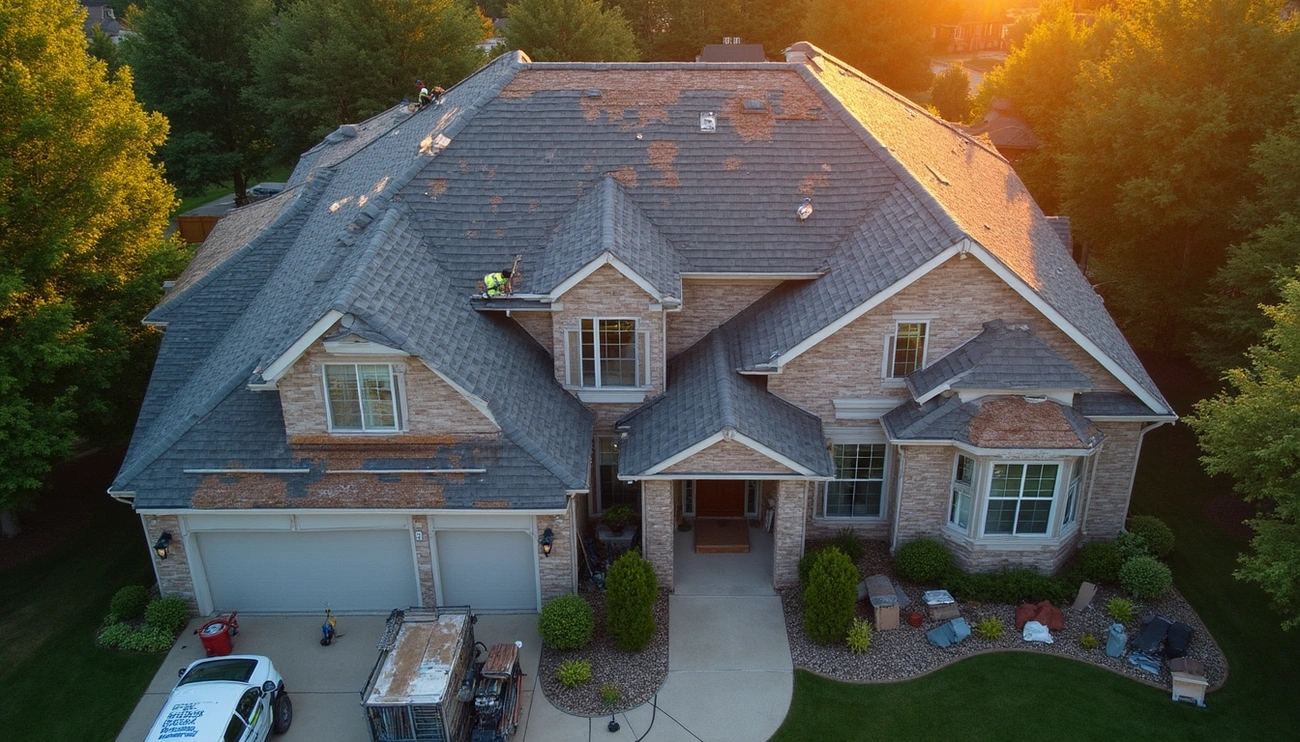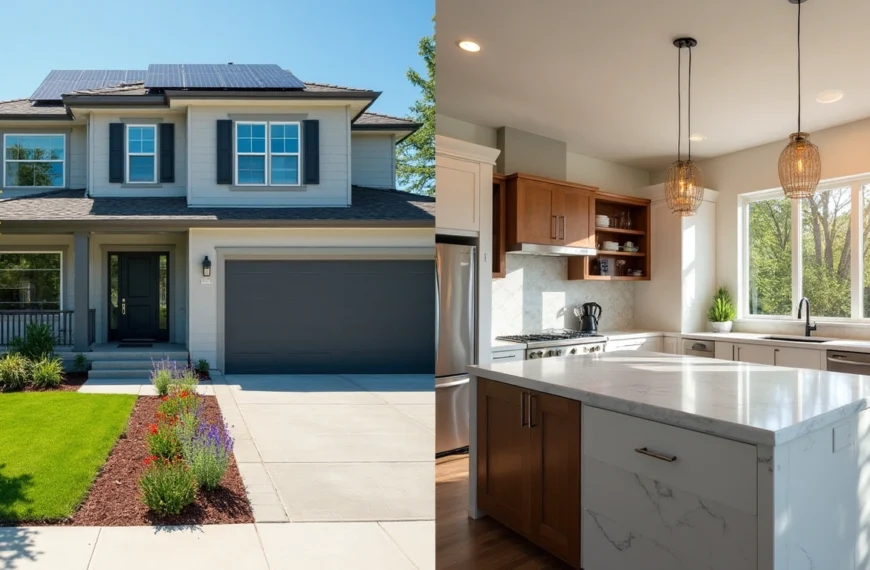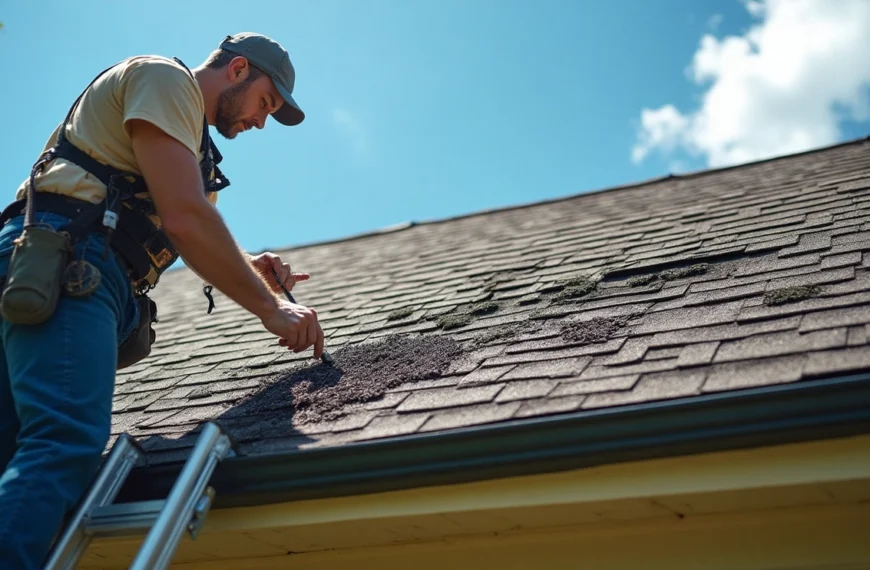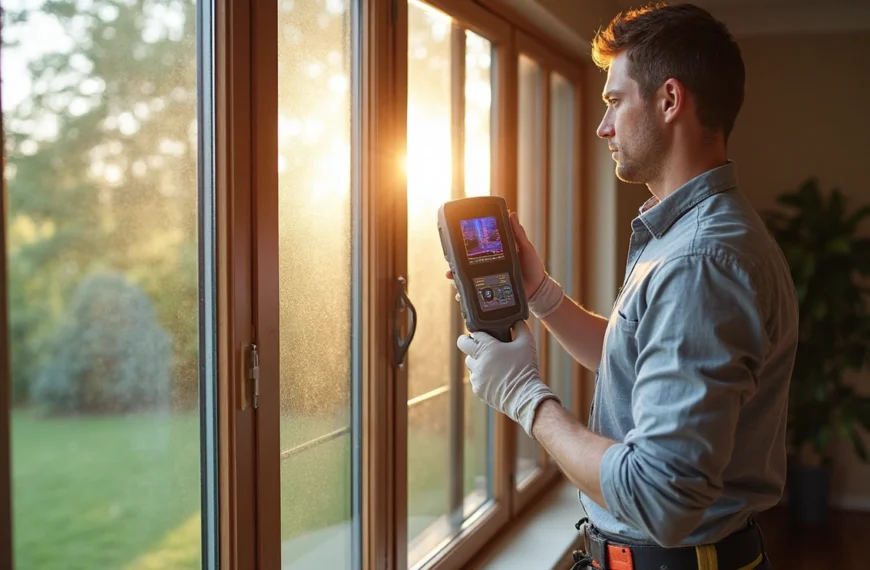Roof Replacement costs greatly affect what you’ll pay to replace a roof. Most homeowners spend between $5,868 and $13,216 for the whole project. The price can vary a lot more based on several factors. Replacement costs usually run from $4 to $11 per square foot. Your choice of material makes a big difference. Asphalt shingles cost between $3.50 and $6.00 per square foot. Premium materials like slate can cost anywhere from $25,000 to $50,000 for a complete roof.
Knowing what shapes these costs helps you make smart decisions and get better estimates. Workers’ wages make up 60% of your total cost, and rates range from $1.50 to $3.75 per square foot. Your location plays a major part in the final price. Minnesota’s costs show this clearly, with homeowners paying between $25,000 to $45,000 for roof replacements. You can use a roofing cost calculator to get rough numbers quickly. Understanding how roof size, material choice, and local pricing shape your final estimate helps you budget better. This piece breaks down average roofing costs and material prices to help you plan this major home upgrade.
Understanding the key cost drivers in roof replacement
The final price of a roof replacement depends on three key factors: materials, labor, and location. Roofing professionals calculate costs in “squares,” and each square equals 100 square feet of roof area.
Material, labor, and location as core factors
Materials make up 40%-50% of your total roof replacement cost. Your choice of roofing material makes a big difference in the final cost. Asphalt shingles range from $3.50 to $6.00 per square foot. Premium materials like slate or tile cost more, ranging from $10.00 to $40.00 per square foot.
Labor costs take up about 60% of the total project cost. Professional roofers usually charge $11.00 per square foot or $60.00 per hour. These rates change based on experience. Skilled roofers can charge up to $130.00 per hour while general laborers charge $35.00 per hour.
Your location affects pricing through:
- How easily available materials are and shipping costs
- Local building codes and permit fees (usually $75.00-$250.00)
- Weather conditions that require specific materials or installation methods
How roof size and shape influence pricing
The average American roof measures about 1,700 square feet, according to the U.S. Census Bureau. An asphalt shingle roof this size typically costs around $7,153.00.
The complexity of your roof plays a big role in labor costs. Your price might go up because of:
- Multiple angles, valleys, and ridges
- Steep pitches (over 6:12) that need extra safety gear
- Special features like dormers, skylights, and chimneys
- Buildings taller than two stories that slow down work and need more safety measures
Using a roofing cost calculator for estimates
Roofing calculators online give you rough estimates by looking at:
- Your roof’s square footage
- What materials you want
- How steep and complex your roof is
- Price differences in your area
All the same, these tools only give you a rough idea. “Online calculators may not consider all factors that affect price, such as roof condition, material availability, or additional costs,” says one industry expert. Most professionals suggest getting an in-person assessment to get the full picture of your roof’s specific needs.
Comparing roofing materials: cost vs. value
Image Source: Leverage Roofing
The right roofing material needs a balance between upfront costs and long-term value. Different options bring their own mix of durability, looks, and return on investment.
Low-cost options: asphalt and composite shingles
Asphalt shingles dominate the American roofing market because they’re affordable, with prices from $4.25 to $8.25 per square foot. These shingles last 15-25 years, and architectural versions can go 25-28 years. A full roof replacement costs homeowners between $5,000 and $18,000.
Composite shingles are more durable but cost more—between $7.50 and $13.00 per square foot. Their 35-50 year lifespan and low maintenance needs make them worth the extra money. These engineered shingles stand up to harsh weather and help the environment since manufacturers make many from recycled materials.
Mid-range: metal and wood shake
Metal roofs have become a popular choice. Aluminum and steel options cost $7.00 to $15.00 per square foot. Premium metals like copper range from $18.00 to $30.00 per square foot. These roofs last 40-70 years, outlasting several asphalt installations.
Cedar shake roofs bring natural beauty at $8.00 to $14.00 per square foot. An average home needs $18,000 to $25,000 for installation, but the 30-50 year lifespan makes cedar competitive with other premium choices. Cedar roofs need regular upkeep to last longer, particularly in wet climates.
High-end: tile, slate, and solar roofs
Clay and concrete tile roofs cost $6.65 to $25.00 per square foot. Clay tiles last 75-100 years while concrete versions go 40-60 years. This remarkable durability justifies their higher price tag.
Slate roofs cost $10.00 to $30.00 per square foot. Good installation helps slate roofs last 75-150 years. Many homeowners see slate as a lifetime investment.
Solar roofs showcase innovative technology, priced at $15.00 per watt or $63.00 per square foot. Tesla Solar Roof installations average $106,000—five times more than standard solar panels. In spite of that, power generation and 25-year warranties make them valuable.
Roofing materials prices and lifespan comparison
Here’s what you get for your money:
- Simple asphalt shingles: $80-$130 per square, 15-20 years
- Architectural shingles: $100-$250 per square, 20-30 years
- Metal roofing: $100-$800 per square, 30-80 years
- Wood shakes: $300-$700 per square, 25-30 years
- Slate/stone: $600-$1,600 per square, 50-200 years
Asphalt shingles are the cheapest option, but premium materials like metal, slate, and composite deliver better value through longer life spans and less maintenance.
Labor costs and what influences them
Image Source: Openbox Roofing
Labor takes up the biggest chunk of your roof replacement budget. You’ll spend 50% to 60% of your total cost on labor alone. Knowing what affects these costs will help you make smart decisions and save money on your roofing project.
Crew size and project duration
Your roof replacement’s final price depends on the number of workers and time needed. Roofing contractors adjust their team size based on how complex your roof is. Simple projects need just a small crew, but steep or complex roofs need skilled workers who charge more per hour. While smaller crews might seem cheaper at first, they can get pricey with delays. Too many workers on site will drive up your costs needlessly.
The time of year plays a big role in your costs. Northern regions face shorter days and slower work in winter’s cold temperatures, which can increase labor costs. Down south, summer heat might force crews to work at night for higher rates. You can get better prices by booking during times when contractors aren’t as busy.
Roof accessibility and safety requirements
Getting to your roof can drive up labor costs quickly. Here’s what makes roof access tough:
- Landscaping or bushes right under the roofline
- Fences around the property
- No paved areas near access points
- Buildings too close to each other
Two similar roofs can have very different labor costs just because one is harder to reach. On top of that, safety equipment requirements for steep roofs (over 6:12 pitch) mean more setup time and special gear, which costs more.
Tear-off and disposal costs
Taking off your old roof adds a lot to your bill. Tear-offs usually cost $1.00 to $5.00 per square foot. Multiple layers mean more work to remove and clean up. Contractors add dump fees for roofing debris to your final cost.
How to read a roofing estimate
A good roofing estimate breaks down all the planned work instead of giving you one big number. Look for details about tear-offs, property protection, installation, cleanup, and warranty information. Each line item includes labor costs rather than listing them separately.
The best estimates include extra costs for replacing bad roof decking that crews might find during tear-off. This is usually priced per sheet or board. The most valuable thing you can do is go through the estimate with your contractor to make sure you understand all the charges.
How your location changes everything
Your home’s location plays a key role in roof replacement decisions. The place you live shapes material choices and costs.
Climate and weather considerations
Local weather patterns guide roofing material choices and project timing. Clay tile roofing remains popular in the Southwest because it spreads heat evenly and cuts cooling costs during hot summers. The Pacific Northwest gets lots of rain, so composite shingles work best there because they resist water well.
The time of year matters too. Shingles become brittle in cold weather, which can hurt installation quality. Even mild seasons bring challenges – Raleigh’s random rainstorms can stop work midway. Roofers prefer working in summer when weather stays steady, but this means higher prices and longer waits.
Regional pricing trends
Location changes roofing costs in several ways. Cities have better access to materials, which can mean lower costs. But urban areas also charge more because living costs run higher.
The number of available workers creates big price differences between regions. Labor availability gets tight in areas with construction booms, pushing contractor rates up. Areas with many roofing companies tend to have better prices due to competition.
Permit, inspection, and code compliance
Permit fees range from $100 to $500 based on where you live. Building rules vary between states – California focuses on saving energy while Florida puts hurricane protection first.
New York charges $50-$200 for residential roofing permits, depending on the job size. Some cities skip permit requirements for re-roofing or make exceptions for smaller jobs.
Average roofing cost by state
Each state shows different price ranges. New roofs in California cost $6,200-$17,400, while Florida runs $5,400-$15,200. Michigan tops the list at $6,400-$17,900. States like Ohio and Washington fall lower at $5,500-$15,400.
The South leads residential roofing growth because its good weather and strong economy attract new residents. This population trend and local material choices continue to reshape the American roofing market.
Conclusion
Making an informed roofing investment decision
Roof replacement is one of the most important home improvement investments you’ll make. This piece explores how materials, labor, and location are the life-blood of pricing variations nationwide.
Your material choice sets the foundation for budget planning. Asphalt shingles are budget-friendly at $3.50-$6.00 per square foot. Premium materials like slate last longer but cost $10.00-$30.00 per square foot. Smart homeowners weigh the original costs against the long-term value of their investment.
Professional roofers’ labor makes up 60% of total project costs, with rates around $11.00 per square foot. Your roof’s complexity, access points, and the season affect these numbers greatly. The tear-off and disposal costs add $1.00-$5.00 per square foot, especially when workers need to remove multiple layers.
Location plays a crucial role in roof replacement costs. Your local climate determines suitable materials, building codes change between areas, and regional pricing creates big differences between states. Michigan’s average replacement costs ($6,400-$17,900) are higher than Florida’s ($5,400-$15,200), even with Florida’s hurricane requirements.
Smart homeowners get multiple detailed estimates from trusted contractors. These estimates should break down all planned work instead of showing just the total. You can save money by scheduling the work during off-peak seasons without cutting corners on quality.
The best roof replacement matches durability, looks, and budget with your needs. Now that you know about roofing costs, you can talk to contractors, assess their proposals, and make choices that protect your home and wallet for years ahead.
FAQs
Q1. How is the cost of a roof replacement calculated? The cost of a roof replacement is determined by several factors, including the size of the roof, materials used, labor costs, and location. Roofing contractors typically charge by the “square” (100 square feet) and consider the complexity of the roof, accessibility, and local building codes. Materials usually account for 40-50% of the total cost, while labor makes up about 60%.
Q2. What are the most cost-effective roofing materials? Asphalt shingles are generally the most affordable option, costing between $3.50 and $6.00 per square foot. While they have a shorter lifespan of 15-25 years, they offer good value for budget-conscious homeowners. For those looking for a balance between cost and longevity, composite shingles or metal roofing might be worth considering, as they last longer and may provide better long-term value despite higher initial costs.
Q3. How does location affect roof replacement costs? Location significantly impacts roof replacement costs due to variations in climate, building codes, labor availability, and regional pricing trends. For example, areas prone to extreme weather may require more durable materials, while urban areas might have higher labor costs. Additionally, permit fees and code requirements vary by location, further influencing the overall cost.
Q4. What should be included in a roofing estimate? A comprehensive roofing estimate should itemize all planned work, including materials, labor, tear-off and disposal costs, permits, and warranty information.
Q5. Can I save money on my roof replacement? Yes, there are several ways to potentially reduce costs on a roof replacement. Consider scheduling the project during the contractor’s off-peak season, which can lead to better pricing. Obtaining multiple detailed estimates from reputable contractors allows you to compare prices and services.













![No Win No Fee Lawyers: The Hidden Truth About Settlement Cuts Legal representation through no win no fee lawyers gives clients a way to fight cases without paying anything upfront. Many clients don't know that these services take a big chunk of money after winning the case. Lawyers usually take 25% to 40% of what you win as their contingency fee. The amount lawyers take from settlements can add up fast. A $100,000 settlement means your attorney gets $30,000 if they charge a 30% fee after winning your case. Your solicitor's cut might be £10,000 from a £30,000 compensation award, based on your agreement percentage. This payment model stays pretty much the same for no win no fee lawyers in different places, though percentages can change. This piece breaks down what you need to know about contingency fee deals. You'll learn about standard fee ranges, extra costs beyond the basic fee, and times when this payment setup might not work in your favor. Smart clients should think over these money matters before signing up with a lawyer to make better choices about their legal help. What No-Win No-Fee Really Means Image Source: Express Legal Funding A no-win no-fee arrangement, also called a Conditional Fee Agreement, changes the way people get legal help. This payment approach removes the need to pay legal fees upfront and creates a partnership between clients and their attorneys. How contingency fees work No-win no-fee agreements are based on contingency fees. Lawyers get paid only when they win compensation for their clients. Most lawyers take between 25% and 40% of the final amount, based on how complex the case is and where it's filed. Lawyers take their cut after winning the case. To name just one example, see a case where a lawyer wins £30,000 in compensation with a 33% fee - they would receive £10,000. On top of that, some law firms use sliding scales where they charge less for quick settlements and more if the case goes to trial. The law requires a written agreement before any work starts. This paperwork spells out the lawyer's percentage, what costs you'll need to cover, and other key details. What happens if you lose the case The meaning behind "no-win no-fee" is clear - losing your case means you won't pay your lawyer anything. All the same, you should know about a few money-related details. You won't owe your lawyer when you lose, but some deals might make you pay for court fees, expert witnesses, or other case expenses. The other side could also ask you to pay their legal costs. Many lawyers suggest getting "After Event" insurance to protect their clients. These policies cover any costs if you lose your case, which makes the no-win no-fee setup much safer. Why lawyers offer this model Lawyers want to make legal help available to more people, so they offer these payment plans. This setup helps people who don't have much money take legal action when they have valid claims. The payment structure motivates lawyers to work hard. They only get paid by winning cases, which pushes them to get the best results possible. Lawyers carefully assess each case before taking it on a no-win no-fee basis. They usually accept cases that have a good chance of winning, since they put in lots of time and resources without any guaranteed payment. The Real Cost: How Much Do Lawyers Take from a Settlement Image Source: Greiner Law Corp. The true cost of no-win no-fee legal representation becomes clear once we look at contingency fees. Many clients feel surprised to see a big chunk of their settlement checks going to their attorney's fees. Typical percentage ranges (25%–40%) No win no fee lawyers typically ask for 25% to 40% of the total settlement amount. Personal injury attorneys usually take 33.3% (one-third) of the awarded compensation[101]. Lawyers and clients agree on this percentage before any work starts on the case. Several factors shape the final percentage. Your chances of winning, case complexity, and the work to be done play key roles in determining the attorney's cut. Some areas have laws that cap the maximum contingency fees for specific types of cases. Sliding scale based on case complexity Law firms often use a tiered fee system that changes with the case stage and complexity. This scale rewards quick settlements while paying attorneys fairly if more work becomes needed. The fee might start at 30% if the case settles before lawsuit filing. This number could climb to 35% after filing or reach 40% if the case goes to trial. Law firms often group cases by complexity: 10%-20%: Simple cases with straightforward settlements 25%-35%: Typical personal injury cases 35% and above: Complex cases requiring extensive resources Examples of payout breakdowns These ground examples show how fees affect settlements: A $15,000 settlement with a 33.3% contingency fee.pdf) puts $5,000 in the attorney's pocket, leaving $10,000 for the client. Similarly, from a $100,000 settlement with a 33% fee, the attorney gets $33,000 while the client receives $67,000[102]. Complex cases tell a different story. A $100,000 settlement with a 30% fee plus $5,000 in extra costs leaves $65,000 for the client after all deductions. These fees substantially change the client's final payout. Hidden Costs You Might Not Expect Image Source: Nelson Personal Injury Lawyers Beyond percentage-based fees, clients often feel surprised by extra costs that can reduce their final compensation by a lot. These hidden costs show up in the fine print of no-win no-fee agreements. You should think over these details before signing. Court filing and expert witness fees Legal proceedings come with unavoidable court filing fees. These charges differ by jurisdiction. They usually range from $30 for small claims to several hundred dollars for complex civil lawsuits. Expert witnesses can be expensive, with hourly rates ranging from $150 to $1,000 based on their credentials and testimony complexity. Expert witnesses charge more for court appearances than consultation work because of added pressure and prep time. Clients might still need to pay experts for their prep work even if the case settles before trial. Medical report and investigation costs Medical documentation is a vital part of many legal claims. These costs include fees to release medical records, create specialized reports, and prepare documents. Investigation costs cover evidence gathering, police reports, witness interviews, and other fact-finding work needed to build a strong case. Of course, some firms say they'll cover these expenses upfront, but clients don't completely avoid these costs. When these costs are deducted from your compensation Law firms take these expenses from the settlement amount before they calculate their percentage fee, though each firm handles this differently. Some lawyers subtract these costs after figuring out their contingency fee, which changes how much money clients end up with. Most firms pay case-related costs during the process and get their money back from the settlement. The defendant usually pays most simple legal costs and disbursements in successful cases, but not always everything. Insurance protects clients from costs in unsuccessful claims at many law firms, but this protection isn't guaranteed. Clients should review their agreements carefully since they might still need to pay specific expenses even if they lose their case. When No-Win No-Fee Might Not Be the Best Option Contingency fee arrangements give many people access to justice. However, this payment model doesn't always work in a client's best interests. Knowing these limitations helps clients make better decisions about their legal representation. Cases with unclear liability Lawyer no win no fee arrangements work best in cases where fault is clear. We assessed the probability of success before taking contingency cases. Lawyers might turn down cases if there isn't enough evidence of the other party's negligence or if liability isn't certain. Cases with multiple responsible parties create more challenges. The situation gets complicated fast when several parties share liability. Lawyers are less likely to take these cases on contingency. They need to be confident they can prove the other party's negligence before accepting a case. Low-damage or low-payout claims Small claims often don't work well with the contingency model, even with real injuries. Cases that have minimal injuries or limited financial damages might not bring enough compensation to cover legal costs. The potential settlement needs to be big enough to pay for investigations, witness interviews and court fees. Personal injury lawyers often turn down cases where the "compensation potential" is too small. This doesn't mean the claim isn't valid - it just means the economics don't add up for a contingency arrangement. Situations where hourly billing may be better Hourly billing has clear advantages in certain cases. Clients see exactly what they're paying for - every hour worked and task completed. This model works well for cases that need lots of attention but don't have clear financial outcomes. Complex litigation with opposing parties works better with hourly billing and a retainer fee. Clients have more control over their case and don't feel pressured to settle quickly. Cases that need extensive preparation but have uncertain outcomes fit the hourly model better. Lawyers can spend the time needed without worrying about contingency limits. This approach often leads to better representation, especially for complex legal issues that need special expertise. Conclusion Understanding the Full Picture Before You Sign No-win no-fee arrangements offer legal representation without upfront costs. Of course, this seems attractive at first glance. In spite of that, you need to think about how these agreements can affect your final compensation. Legal fees usually range from 25% to 40% of your settlement - but that's just the start. You'll face more deductions like court filing fees, expert witness costs, and charges for medical documentation. What looks like a "free" service ends up taking a big chunk of your compensation to cover legal expenses. These arrangements work best in specific situations - cases with obvious liability, substantial damages, and solid evidence. If you have a low-value claim or complex liability issues, traditional hourly billing might serve you better. Without doubt, you should ask for clear explanations of all possible costs before signing anything. Read the fine print closely, especially when you have to deal with expenses in unsuccessful cases. Ask to see sample settlement breakdowns that show all deductions. This helps you picture what you might actually take home. Your choice to go with a no-win no-fee arrangement depends on your situation. This model helps if you don't have money to pursue valid claims. But if you have a strong case and enough funds, other fee structures might let you keep more of your compensation. Whatever payment model you choose, knowing exactly how much lawyers take from settlements helps you make better decisions. This knowledge lets you approach legal representation with real expectations and better control over your money. FAQs Q1. What percentage of a settlement do no-win no-fee lawyers typically take? No-win no-fee lawyers typically charge between 25% to 40% of the final settlement amount as their contingency fee. The exact percentage often depends on the complexity of the case and the stage at which it is resolved. Q2. Are there any hidden costs in no-win no-fee arrangements? Yes, there can be additional costs beyond the lawyer's percentage fee. These may include court filing fees, expert witness costs, medical report expenses, and investigation costs. These expenses are usually deducted from the settlement amount before or after the lawyer's fee is calculated. Q3. What happens if I lose my case in a no-win no-fee arrangement? If you lose your case, you generally won't have to pay your lawyer's fees. However, you might still be responsible for certain expenses like court costs or the opposing party's legal fees. Many lawyers offer insurance to protect clients from these potential costs in case of an unsuccessful claim. Q4. When might a no-win no-fee arrangement not be the best option? No-win no-fee arrangements may not be ideal for cases with unclear liability, low-value claims, or complex legal issues requiring extensive preparation. In these situations, traditional hourly billing might be more appropriate and potentially more cost-effective for the client. Q5. Can I negotiate the percentage a lawyer takes from my settlement? Yes, the contingency fee percentage is often negotiable. It's typically agreed upon and formalized in writing before the lawyer begins working on your case. Don't hesitate to discuss the fee structure with your lawyer and ask for a detailed breakdown of potential costs and deductions.](https://consumersweek.com/wp-content/uploads/2025/06/No-Win-No-Fee-Lawyers-The-Hidden-Truth-About-Settlement-Cuts-870x570.webp)

